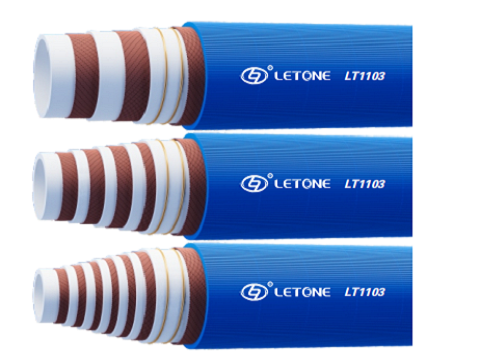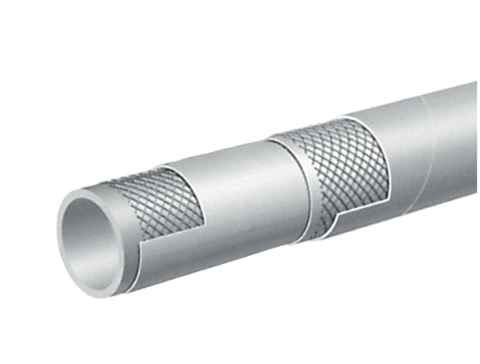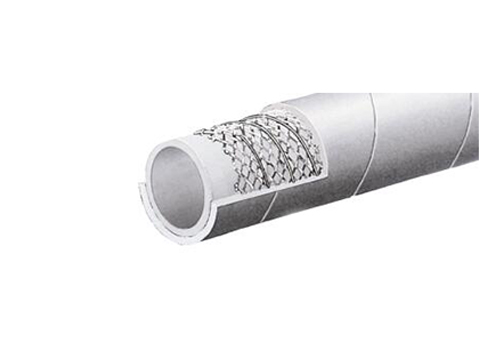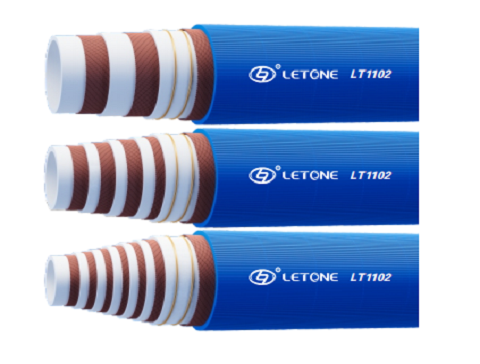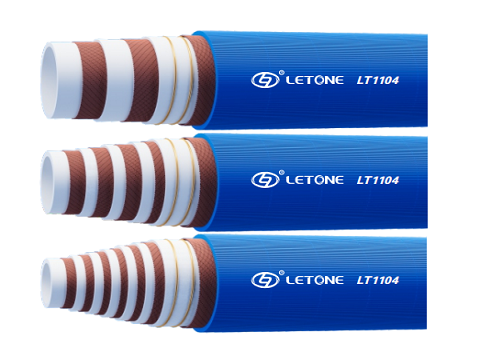With the continuous development of industrial technology, hydraulic transmission, as an efficient and accurate transmission method, is widely used in various mechanical equipment. In hydraulic transmission systems, hydraulic hoses are an indispensable part. Among them, steel wire braided hydraulic hoses are a common type, widely used due to their high pressure resistance and long service life. This article will introduce the characteristics, structure, and selection precautions of steel wire braided hydraulic hoses.
1、 Characteristics of Steel Wire Braided Hydraulic Hoses
The steel wire braided hydraulic hose mainly consists of an inner rubber layer, a steel wire layer, and an outer rubber layer. Among them, the inner rubber layer directly contacts the hydraulic oil, so it needs to have good wear resistance and oil resistance; The outer adhesive layer serves to protect the steel wire layer, so it needs to have high elasticity and aging resistance. The steel wire layer is the main supporting structure of the hose, so it needs to have high strength and pressure resistance.
Compared to traditional rubber hoses, steel wire braided hydraulic hoses have the following advantages:
1. Higher pressure resistance. Due to the supporting effect of the steel wire layer, the pressure resistance of the steel wire braided hydraulic hose is higher than that of the rubber hose, and it can withstand higher working pressure.
2. Longer service life. Due to the good wear resistance and oil resistance of steel wire braided hydraulic hoses, their service life is much longer than that of rubber hoses.
3. Wider scope of application. Steel wire braided hydraulic hoses have good high-temperature and low-temperature resistance, which can be used in different environments and have a wider range of applications.
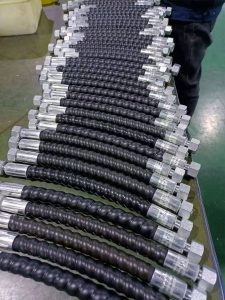 2、 Structure of Steel Wire Braided Hydraulic Hoses
The structure of steel wire braided hydraulic hoses mainly consists of an inner rubber layer, a steel wire layer, and an outer rubber layer.
1. Inner adhesive layer
The inner rubber layer is directly in contact with hydraulic oil, so it needs to have good wear resistance and oil resistance. Usually, nitrile rubber or chloroprene rubber with good oil resistance is used as the material for the inner rubber layer. In the inner adhesive layer, an appropriate amount of fiber skeleton material will also be added to improve the strength and pressure resistance of the inner adhesive layer.
2. Steel wire layer
The steel wire layer is the main supporting structure of the steel wire braided hydraulic hose, usually made of high-strength and high toughness stainless steel wire or high carbon steel wire as the material. After pre-treatment, these steel wires are woven onto the inner adhesive layer by a weaving machine to form a dense and uniform layer of steel wires. During the weaving process, special heat treatment processes are also used to improve the strength and pressure resistance of the steel wire layer.
3. Outer adhesive layer
The outer adhesive layer mainly serves to protect the steel wire layer, so it needs to have high elasticity and aging resistance. Usually, materials such as polyurethane, polyester, or acrylate are used as the material for the outer adhesive layer. In the outer adhesive layer, an appropriate amount of fiber skeleton material will also be added to improve the strength and pressure resistance of the outer adhesive layer.
3、 Selection precautions
When selecting steel wire braided hydraulic hoses, the following points should be noted:
1. Working pressure range. The working pressure that different specifications of hoses can withstand varies, so the selection needs to be based on the actual working pressure range.
2. Operating environment. Due to the excellent high-temperature and low-temperature resistance of steel wire braided hydraulic hoses, it is necessary to pay attention to their applicability when used in different environments.
3. Length and diameter. The length and diameter of hoses of different specifications also vary, so the selection needs to be based on actual needs.
2、 Structure of Steel Wire Braided Hydraulic Hoses
The structure of steel wire braided hydraulic hoses mainly consists of an inner rubber layer, a steel wire layer, and an outer rubber layer.
1. Inner adhesive layer
The inner rubber layer is directly in contact with hydraulic oil, so it needs to have good wear resistance and oil resistance. Usually, nitrile rubber or chloroprene rubber with good oil resistance is used as the material for the inner rubber layer. In the inner adhesive layer, an appropriate amount of fiber skeleton material will also be added to improve the strength and pressure resistance of the inner adhesive layer.
2. Steel wire layer
The steel wire layer is the main supporting structure of the steel wire braided hydraulic hose, usually made of high-strength and high toughness stainless steel wire or high carbon steel wire as the material. After pre-treatment, these steel wires are woven onto the inner adhesive layer by a weaving machine to form a dense and uniform layer of steel wires. During the weaving process, special heat treatment processes are also used to improve the strength and pressure resistance of the steel wire layer.
3. Outer adhesive layer
The outer adhesive layer mainly serves to protect the steel wire layer, so it needs to have high elasticity and aging resistance. Usually, materials such as polyurethane, polyester, or acrylate are used as the material for the outer adhesive layer. In the outer adhesive layer, an appropriate amount of fiber skeleton material will also be added to improve the strength and pressure resistance of the outer adhesive layer.
3、 Selection precautions
When selecting steel wire braided hydraulic hoses, the following points should be noted:
1. Working pressure range. The working pressure that different specifications of hoses can withstand varies, so the selection needs to be based on the actual working pressure range.
2. Operating environment. Due to the excellent high-temperature and low-temperature resistance of steel wire braided hydraulic hoses, it is necessary to pay attention to their applicability when used in different environments.
3. Length and diameter. The length and diameter of hoses of different specifications also vary, so the selection needs to be based on actual needs.

